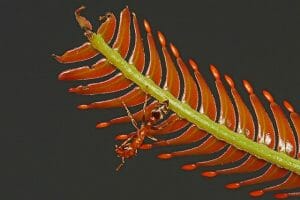Coevolution Definition
In the context of evolutionary biology, coevolution refers to the evolution of at least two species, which occurs in a mutually dependent manner. Coevolution was first described in the context of insects and flowering plants, and has since been applied to major evolutionary events, including sexual reproduction, infectious disease, and ecological communities. Coevolution functions by reciprocal selective pressures on two or more species, analogous to an arms race in an attempt to outcompete each other. Classic examples include predator-prey, host-parasite, and other competitive relationships between species. While the process of coevolution generally only involves two species, multiple species can be involved. Moreover, coevolution also results in adaptations for mutual benefit. An example is the coevolution of flowering plants and associated pollinators (e.g., bees, birds, and other insect species).
Coevolution Examples
Predator-Prey Coevolution
The predator-prey relationship is one of the most common examples of coevolution. In this respect, there is a selective pressure on the prey to avoid capture and thus, the predator must evolve to become more effective hunters. In this manner, predator-prey coevolution is analogous to an evolutionary arms race and the development of specific adaptations, especially in prey species, to avoid or discourage predation.
Herbivores and plants
Similar to the predator-prey relationship, another common example of coevolution is the relationship between herbivore species and the plants that they consume. One example is that of the lodgepole pine seeds, which both red squirrels and crossbills eat in various regions of the Rocky Mountains. Both herbivores have different tactics for extracting the seeds from the lodgepole pine cone; the squirrels will simply gnaw through the pine cone, whereas the crossbills have specialized mandibles for extracting the seeds. Thus, in regions where red squirrels are more prevalent, the lodgepole pine cones are denser, contain fewer seeds, and have thinner scales to prevent the squirrels from obtaining the seeds. However, in regions where crossbills are more prevalent, the cones are lighter and contain thick scales, so as to prevent the crossbills from accessing the seeds. Thus, the lodgepole pine is concurrently coevolving with both of these herbivore species.
Acacia ants and Acacias
An example of coevolution that is not characteristic of an arms race, but one which provides a mutual benefit to both a plant species and insect is that of the acacia ants and acacia plants. In this relationship, the plant and ants have coevolved to have a symbiotic relationship in which the ants provide the plant with protection against other potentially damaging insects, as well as other plants which may compete for nutrients and sunlight. In return, the plant provides the ants with shelter and essential nutrients for the ants and their growing larvae (shown below).
Flowering Plants and Pollinators
Another example of beneficial coevolution is the relationship between flowering plants and the respective insect and bird species that pollinate them. In this respect, flowering plants and pollinators have developed co-adaptations that allow flowers to attract pollinators, and insects and birds have developed specialized adaptations for extracting nectar and pollen from the plants (shown below).
Research indicates that there are at least three traits that flowering plants have evolved to attract pollinators:
- Distinct visual cues: flowering plants have evolved bright colors, stripes, patterns, and colors specific to the pollinator. For example, flowering plants seeking to attract insect pollinators are typically blue an ultraviolet, whereas red and orange are designed to attract birds.
- Scent: flowering plants use scents as a means of instructing insects as to their location. Since scents become stronger closer to the plant, the insect is able to hone-in and land on that plant to extract its nectar.
- Some flowers use chemical and tactile means to mimic female insect species to attract the male species. For example, orchids secrete a chemical that is the same as the pheromones of bee and wasp species. When the male insect lands on the flower and attempts to copulate, the pollen is transferred to him.
Hummingbirds are another type of pollinator that have coevolved for mutual benefit. The hummingbirds serve as pollinators and the flowers supply the birds with nutrient-rich nectar. The flowering plants attract the hummingbirds with certain colors, the shape of the flower accommodates the bird’s bill, and such flowers tend to bloom when hummingbirds are breeding. Coevolution of such flowering plants with various hummingbird species is evident by the distinct shape and length of the flower’s corolla tubes, which have adapted to the shape and length of the hummingbird bill that pollenates that plant. The shape of the flower has also adapted such that the pollen becomes attached to a particular region of the bird while it consumes the nectar from the flower (shown below).
Quiz
1. Which of the following statements is TRUE regarding coevolution?
A. Coevolution can result in a symbiotic or mutually beneficial relationship between two species.
B. Coevolution can be the result of selective pressures between two species, resulting in an arms race between them.
C. Both A and B are correct
D. None of the above
2. Which of the following is NOT an example of coevolution?
A. Acacia ants and lodgepole pines
B. Acacia ants and acacia plants
C. Crossbills and lodgepole pines
D. Red squirrels and lodgepole pines
3. An example of coevolution for mutual benefit is:
A. Red Squirrels and lodgepole pines
B. Crossbills and lodgepole pines
C. Large mammalian predators (e.g., foxes, wolves) and hedgehogs or skunks
D. Acacia ants and acacia plants
References
- Endara et al. (2017). Coevolutionary arms race versus host defense chase in a tropical herbivore– plant system. PNAS. 114(36): E7499-E7505.
- Janzen, D. (1966). Coevolution of mutualism between ants and acacias in Central America. Evolution. 20(3): 249-275.



